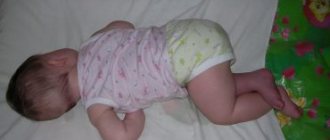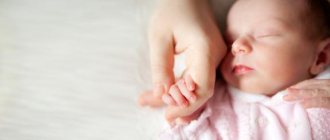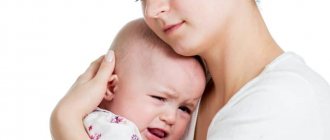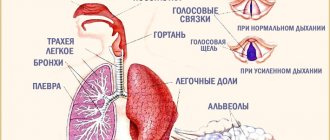Translated from Latin, “tremor” means shaking. Today, this term usually refers to involuntary rhythmic movements caused by muscle contraction. Everyone has probably experienced this condition. However, if a person constantly feels tremor, then most likely the cause is some kind of pathology. To get rid of this symptom, you must first figure out what caused it. In this review, we will look at why a child’s hands are shaking and how you can help your child cope with this condition.
What is a tremor and when does it go away?
This term refers to systematic twitching of a child’s arms, legs, chin, and head. If this phenomenon is accompanied by an increase in tone in muscle tissue, we can conclude that the baby’s nervous system is not sufficiently formed and is highly excitable.
This condition occurs quite often - in approximately every second baby. Muscle contraction in most cases occurs during sleep or during strong arousal.
Head tremors
It may appear in a baby if the centers of nerve endings that are located in his brain and are responsible for movements are underdeveloped. In addition, this is often facilitated by an increase in the hormone norepinephrine in the blood.
Tremors of the arms, legs, chin, or lips
often occurs in premature babies. This is due to the fact that their nervous system has not had time to form, and maturation outside the mother's womb is still considered unnatural even with proper care.
Tremor in newborns
does not need correction until three months, but parents must understand that the child has a problem that requires their close attention.
The baby’s nervous system is very dynamic and susceptible to external influences, and therefore, with adequate treatment, its condition is easily normalized and restored.
Consequences
The child experiences the very first consequences of tremor in infancy - nervousness and frequent crying. Sleep is gradually disturbed, and the range of movements increases. Trembling begins to appear for absolutely no reason.
Tremor itself has no effect on life expectancy. But pathology in a child over a year old and in an adult always signals a neurological disease, a disorder of the cerebellum or an accumulation of copper in the blood, liver or membranes of the brain.
The danger of the disease lies in the gradual loss of ability to work. This is especially true for people who do not treat the tremor at the same time as its cause. Parkinson's disease (which mostly occurs in older people) also develops slowly.
With the birth of a baby, most mothers have questions about why the baby starts to flinch during sleep. Especially in the first months of birth, almost all babies shudder. Most likely, this is due to the restructuring of the body. After all, at birth a child finds himself in a completely different world.
Previously, he felt calm, his mother’s heart beat evenly, but now everything is different. When he sleeps, he feels insecurity, the absence of a loved one and the conditions to which he is accustomed. He also senses the presence of many unusual and unfamiliar sounds and smells.
Causes of tremor
This condition can appear due to various reasons, the most common of which are:
- Immaturity of the nervous system.
During the first weeks after birth, the child’s nervous system cannot be fully responsible for the functions performed, which is the reason for the development of tremor. In most cases, twitching occurs due to the fact that the nerve centers located in the brain are not able to work correctly.Also, this condition can be caused by an excess of the hormone norepinephrine in the blood, which indicates that the nerve centers of the adrenal glands have not yet been fully formed.
- Hypoxia.
This condition can occur during pregnancy or during childbirth. Of course, it has a serious impact on the functioning of the brain. Intrauterine infections, threats of miscarriage, bleeding, and polyhydramnios lead to the development of hypoxia.During childbirth, labor that is too long or too fast can lead to this condition. Other causes include placental abruption and umbilical cord entanglement. As a result, there is a disruption in the supply of oxygen to the brain, which causes tremor.
- Premature birth.
In children who were born ahead of schedule, tremor appears quite often, because their nervous system simply did not have time to fully form in the mother’s womb.
Tremor in children older than one year
In some cases, episodes of physiological or pathological tremor can be observed in children older than one year (up to adolescence).
Symptoms
Most often, physiological tremor is observed when the child is excited: nervousness, fear or strong emotions. It can be expressed in twitching of the lips, chin, upper and lower extremities. As a rule, its episodes are always associated with overstrain of the child’s nervous system and are short-term in nature.
With pathological tremor, which accompanies various disorders of the nervous system, other parts of the body (head, facial muscles, tongue and torso) may also be involved in twitching. Episodes of such tremors in children can be observed at rest or when trying to perform normal movements that are not associated with nervous tension. In addition to muscle twitching, symptoms of other disorders in the nervous system may be observed: headaches, poor sleep, excessive irritability.
Neurologists distinguish several types of tremor:
- Benign tremor
is more often observed in adolescents; at first one hand may tremble, then the second is involved in the process; if not treated in a timely manner, trembling of the tongue, larynx and other parts of the body may appear. - Postural tremor
- often transmitted by heredity, accompanied by disorders of the thyroid gland, nervousness and anxiety; trembling of the hands can usually only be noticed when they are extended. - Intention tremor
– develops when the cerebellum is damaged and is accompanied by difficult coordination of movements (the child experiences sharply defined “jerks” in habitual movements). - Asterixis
is the most severe form of tremor, which is accompanied by uncertain and slow attempts to flex and extend the upper limbs and occurs against the background of renal or liver failure.
Causes
The cause of physiological tremor in children after one year is the immaturity of the nervous system. As a rule, after its full maturity, episodes of “bouncing” disappear and leave no negative consequences.
The causes of pathological tremor in children over one year old can be various pathologies of both the nervous and other body systems:
- severe hypoxia during pregnancy;
- infectious diseases suffered by the mother;
- sepsis;
- threat of miscarriage, rapid or premature birth;
- thyroid diseases;
- birth injuries;
- severe pathologies of the liver and kidneys;
- hereditary and degenerative diseases of the nervous system;
- neuroses and other nervous diseases.
Clinical picture of the disease
Tremor in newborns has a specific course and has characteristic manifestations:
- As a rule, with tremors in newborns, the lower lip and chin most often tremble. Less commonly, twitching of the lower or upper extremities is observed.
- Trembling can be asymmetrical - in this case, parts of the body tremble separately. For example, the chin and arms, one leg and one arm can tremble at the same time.
- If the tremor is symmetrical and not too intense, this is also considered a normal variant. The movements in both situations are small and rhythmic.
- Physiological tremor should last literally a few seconds. Twitching is usually observed during periods of crying or severe nervous tension, for example, after bathing. However, in some cases they may appear suddenly.
- Tremors may first appear or get slightly worse after the first month of life.
Before this, there is a period of adaptation when it is recommended to protect the child from external stimuli. After a month, the baby can already take water and air baths, and therefore the load on the nervous system increases significantly.
Most often, tremor in a newborn baby is a cause for parental concern. However, up to three months, this condition is considered absolutely physiological, and it is caused only by the immaturity of the nervous system.
Parents should be wary if after three months the symptoms of tremor do not decrease, but rather increase. In addition, concerns should be raised by the fact that twitching occurs for no obvious reason, and the child is characterized by increased excitability - for example, he reacts too violently to sudden movements or sounds.
In this case, you should definitely contact a neurologist.
This condition may be associated with diseases such as:
- Sepsis.
- Intracranial hemorrhage.
- Hypocalcemia.
- Hypomagnesemia.
- Hyperglycemia.
- Drug withdrawal syndrome.
Tremor in a child after sleep
Tremor in a child after sleep can be physiological and pathological. With physiological tremor after sleep, which is observed in children under 3 (sometimes 4) months of age, the twitching quickly passes without threatening the baby’s health.
If a pathological tremor after sleep is detected, which can be observed in the presence of neurological and other diseases in older children, parents should consult a neurologist and conduct a series of prescribed examinations. After identifying the causes of pathological tremor, the doctor can recommend a course of treatment: relaxing massage, exercise therapy, air baths, baths with sedative herbs, physiotherapeutic procedures or drug treatment.
Treatment methods
Tremor in newborns is considered a completely normal phenomenon, which occurs in every second child. Dr. Komarovsky claims that the nervous system of a newborn baby has a number of distinctive features.
At the same time, the baby’s muscle tone is more clearly expressed in the muscles that bend his arms and legs. This is why tremor is considered completely normal and does not require treatment.
If twitching occurs exclusively during fright, crying and during REM sleep, then parents should not worry. If there are no apparent reasons for this condition, the doctor should examine the child.
In most cases, such children are prescribed swimming, gymnastics and therapeutic massage. How to treat tremor in newborns and whether it needs to be treated can only be decided by a specialist.
Most often, regular relaxing massage is indicated in this case. Warm baths with the addition of lemon balm, mint, and valerian can also be prescribed. These herbs have a calming effect, which has a positive effect on the baby’s health.
In order not to cause an allergic reaction, you should not do such baths too often - three times a week will be enough.
Massage technique
It is recommended to start massage for a newborn baby after he is 5-6 weeks old.
All movements used should be performed along the joints, namely from the periphery towards the center.
The massage must be done on a hard surface, and the room must be ventilated and ensure that it is warm enough.
For the procedure to be effective, it is enough to master a few simple movements, these include:
- stroking;
- kneading;
- vibration;
- trituration.
While stroking the baby, movements should be made along the lymph flow in the direction of nearby lymph nodes. The legs should be stroked from the feet to the groin. Hands should be stroked, starting from the hands towards the armpits.
With the help of stroking, it is possible to improve blood supply to internal organs and tissues. This procedure also allows you to relax muscles, relieve pain, and calm the baby.
Rubbing is very beneficial for a child under one year old.
To do this, you need to perform straight and spiral movements with your fingertips. Such procedures have a positive effect on the skin, muscles, ligaments and tendons.
Kneading makes it possible to activate blood circulation and calm the nervous system. It needs to be done gently and at the same time quite energetically.
There are several types of movements that are very useful for children up to one year old and after:
- "Hang glider."
To perform this massage, you need to stroke the baby from the sacrum towards the armpits. With this procedure, it is possible to calm the child and increase the flow of lymph. - "Hot track"
Use the edges of your palms to rub the strip located along the spine. After this procedure, the child’s skin should turn pink. - "Geese."
This massage is performed by pinching the skin on the back.
Moreover, it is recommended to pay special attention to the shoulder blades, shoulders and the area along the spine. movement will be performed in a similar way .
However, in this case the child needs to be tapped. - "Spiral".
When performing spiral movements, it is necessary to move from the sacrum towards the baby’s neck, and this should be done along the spine. During this procedure, it is very important to feel all the vertebrae. - "Wave".
This procedure can be started when the baby's skin is well warmed up. Only in this case your movements will not cause pain in the child. It is necessary to grab a fold of skin with your fingers and begin to quickly finger it. You should move along the spine, from the sacrum to the shoulders and armpits.
In the video you can see techniques for performing massage and gymnastics that will be useful for a newborn with tremors:
Why does a child startle in his sleep and wake up?
Many new parents are concerned that their falling asleep or sleeping child starts and wakes up. Let's look at why your baby might startle and what parents can do to help your baby sleep better.
Startling when falling asleep and during sleep is a normal phenomenon and occurs in the vast majority of infants from birth to 3 months.
Such jerks are called myoclonus. Myoclonus is a sudden involuntary contraction of one or more muscle groups that occurs both during movement and at rest. Myoclonus is most often a normal variant, but in some cases it is a sign of very serious diseases of the central nervous system.
We will talk about why myoclonus occurs and how to cope with it in this article.
Why does the child flinch?
There are three main reasons for such shudders during sleep and when falling asleep: a large proportion of active sleep in infants, the immaturity of the nervous system of children from birth to 6 months and a reaction to external stimuli.
1. Large proportion of active sleep in infants
Newborn babies sleep a lot , but babies' sleep is still undeveloped and is not at all similar to adults.
About 50% of newborn sleep time is active sleep (a prototype of rapid REM sleep), and the phases replace each other without a special system
In the active phase in children, the eyes move quickly under the eyelids, the tone of the body muscles decreases, the pulse and breathing are not regular, babies make quiet sounds, facial expressions constantly change during sleep: smiles, grimaces, expressions of surprise on the face, arms, legs and facial muscles often twitch . The process of suppressing motor activity in a child is not yet complete, so the baby shudders and wakes up.
2. Immaturity of the nervous system
In newborns, the inhibitory mechanisms of the nervous system are not yet sufficiently developed. Therefore, in transitional states - when falling asleep/waking up and transitioning from one phase to another, the baby shudders.
3. Reaction to unexpected stimuli
Startles in sleep can be an involuntary motor reaction of a defensive type in response to unexpected stimuli, such as a sharp sound, sudden light, or unexpected touch. This type of myoclonus intensifies against the background of fatigue, emotional and physical stress.
How to help a child if he starts and wakes up?
What can parents do to suppress these natural muscle contractions in the child and prevent him from waking up?
1. Try swaddling
Swaddling will help soften the natural involuntary startles that can wake your baby.
If swaddling is done safely, it is an easy way to improve sleep , especially for anxious and easily excitable babies. We recommend trying to use loose swaddling from birth until 5-6 months.
There are quite a few types of swaddling. You can find several video instructions on swaddling in open sources, but remember safety! Improper swaddling can lead to overheating, poor circulation and dysplasia.
Therefore, we strongly recommend that you pay attention to the smart and safe swaddling system offered in our store
2. Use white noise
Loose swaddling works more effectively in conjunction with the use of white noise and recreates for the baby sensations similar to those in the womb - slight compression, the sound of blood, warmth, comfort.
White noise:
- activates the calming reflex in the first months of life and is a powerful sleep association for children and adults
- masks external sounds, and your baby’s rest will not be interrupted due to external stimuli
- works as the correct association for falling asleep
- Can be used for both daytime and nighttime sleep
3. Check your sleeping conditions
To help prevent reactions to unexpected stimuli, think about the environment in which your baby sleeps. If your baby may wake up from a sudden muscle contraction, do a quick check on all the important points of the conditions in which the baby sleeps:
— Darkness and silence. Your baby will sleep best in darkness and silence. To adjust external light and noise, you can use blackout curtains and a white noise
Be careful about lighting the room where your baby sleeps. Remember that daylight and artificial light destroy the “sleep hormone” melatonin.
- Comfortable temperature. Do not overheat your baby, but also remember that the cold can cause awakenings. Regularly ventilate the room where the baby sleeps and maintain the temperature at 20-22 degrees. Clothes should be comfortable, not too warm, but the baby should not freeze.
- Safety. Assess the place where the baby sleeps from a safety point of view : it is better to remove excess pillows, toys, blankets and laces from the crib. Remember - the safest crib is an empty crib!
4. Prepare your child for bed, introduce rituals
If you don't already use rituals, now is the time to introduce them! Rituals are a good tool for relaxation and the transition from active wakefulness to sleep:
- Introduce simple rituals after the baby is 6 weeks old
- Spend at least 20-30 minutes on rituals
- Rituals should be used before daytime and nighttime sleep
- Choose relaxing rituals
- If bathing excites your baby too much, reschedule bathing procedures until the morning or earlier in the evening.
- A high-quality ritual should please not only the baby, but also the mother!
The more relaxed the baby is before falling asleep, the less excitement in his nervous system, the calmer his sleep!
5. Child overtired/lack of sleep
Overfatigue is the main enemy of all newborn babies and their parents. An overtired child will take longer to fall asleep and be more restless. This occurs due to an increase in the stress hormone cortisol in the blood, which the body begins to secrete to maintain vigor if it is not possible to fall asleep on time.
To avoid overtiredness, it is necessary to ensure that the child sleeps enough hours a day , and that his periods of wakefulness are not too long for his age.
Remember that norms are average values; deviations from the norm can be either greater or lesser. Eliminate lack of sleep, watch for signs of fatigue, and do not let them turn into signs of overwork.
6. See a doctor
If tremors continue to bother you, talk to a neurologist about this at your next examination. For your peace of mind, it is important that your doctor excludes the possibility of diseases of the central nervous system.
SleepNewborn PhysiologySleep Waking Swaddling
Forecast
If improvements do not appear, and twitching occurs for no apparent reason, you should immediately consult a doctor - there is a possibility that the tremor is a consequence of more serious neurological disorders.
Tremor in newborns is considered an absolutely normal and physiological condition, since it is a consequence of insufficient maturity of the nervous system.
However, this does not mean that its manifestations should be ignored. Only a doctor will be able to determine whether your baby’s twitching is normal or whether it requires special treatment.
Unfortunately, such a phenomenon as tremor in a child, when his muscles involuntarily tremble in various parts of the body, is quite common, and how to deal with it is described in more detail below.
In turn, this trembling is not always evidence of some serious pathology or disorder in the child’s mental development and is often the absolute norm (at a certain age and specific areas of the body).
Thus, neuropathologists distinguish between physiological and pathological tremor in a child, the first of which usually occurs in the early months of the child’s life, manifests itself in a funny tremor of the lips, chin or its limbs and does not pose any danger at all. If tremor in children under one year old does not gradually go away and even, on the contrary, only intensifies or even spreads to all new, seemingly completely uncharacteristic for this phenomenon, areas of the body, then we are most likely talking about some serious negative processes of a neurological nature , secretly occurring in the baby’s body.
It is especially necessary to pay attention to the behavior of the baby at those moments when he cries, gets scared, bathes, wants to eat, expresses his dissatisfaction, sleeps during the daytime, or is being changed. If at this moment his chin, lips or limbs begin to tremble, as a visible reaction to an irritating factor resulting from nervous overstrain, but it quickly passes, then this is a completely natural phenomenon that does not require special adjustments or additional consultation with specialist At the same time, you should be seriously concerned if such a reaction occurs in a baby for no apparent reason, the trembling does not stop for a long time, and relapses occur one after another, because most likely we are talking about some kind of disorder that is in dire need of observation and detailed research.
Typically, such babies are registered with a neurologist and additionally examined during the most significant periods for tremor, which occur in the first, third, sixth, ninth and twelfth months of the child’s life. The cause of pathological tremor usually lies in the underdevelopment of the nerve endings of the brain, which usually arise and can develop as a result of such negative processes and phenomena as prolonged fetal hypoxia, complex entanglement of the umbilical cord, partial placental abruption, and infectious diseases of the mother during pregnancy. Pathological tremor can be provoked in the future by any complication of the birth process, be it rapid labor or, on the contrary, the absence of labor as such, as well as the premature birth of a child.
Often, both types of tremor, under favorable circumstances, go away by the age of one year and do not require any treatment, much less correction with the help of special medications. But after this period, it is still worth starting therapy, if this phenomenon has not gone away, otherwise it can significantly complicate the child’s life until adolescence.
For tremors, a conservative course of treatment is usually provided, which in turn involves creating the most calm atmosphere around the baby, taking daily evening soothing baths with various herbs, therapeutic massage, gymnastics, including breathing, swimming if possible, frequent walks and being in the fresh air. , although more serious methods of correction cannot be ruled out, including surgery. Often, with pathological tremor, the baby is prescribed a whole course of appropriate medications, which are prescribed by a neurologist after a thorough examination.
A very unpleasant external manifestation of pathological tremor is often involuntary trembling of the head, face and other uncharacteristic parts of the body, even in an absolutely calm state (it is not at all necessary that some unfavorable stressful situation should occur at this moment). Often, in parallel with these symptoms, the child experiences poor sleep, excessive irritability, and frequent rather severe headaches.
In turn, doctors conditionally divide tremor into the following four types: benign, postural, intention tremor and asterixis. With benign tremor, which is most often a real scourge for adolescents, one hand of the child begins to shake and gradually the second limb is involved in this process, and over time the tongue and even the muscles of the larynx, as a result of which speech becomes very difficult. Postural tremor is usually the cause of bad heredity or a consequence of serious disorders of the thyroid gland, while it is practically not visualized and can only be noticed if you stretch your arms forward. Intention tremor is inevitably accompanied by damage to the cerebellum and in this case the entire coordination of the child’s movements suffers, however, the most severe form of this disease is still asterixis, which usually occurs against the background of acute renal or liver failure and can manifest itself in extremely slow work of all muscles and, as consequence, result in inhibition of movements.
There are no exceptions when tremor occurs as a reaction to the administration of a vaccine or appears only after waking up. The first case requires close monitoring and sometimes the baby is prescribed additional examination in the form of ultrasound and echo-EG of the brain.
Until three months of age, tremor resulting from vaccination is usually physiological and does not require emergency treatment. In other cases, the neurologist can prescribe an appropriate course of treatment, including physical therapy.
Shaking (or shaking) the head is a fairly common phenomenon among young children. Often this behavior alarms adults who are near the child.
Recommendations for arranging restful sleep for a newborn
- Ventilate the bedroom every day before putting your baby to bed;
- even in severe frost in the nursery, open the window for 5 - 10 minutes;
- Install a thermometer in the bedroom and monitor the temperature. It should not exceed 18-21° C;
- do not wrap the baby up. Dress your child in high-quality, warm pajamas made from natural fabric, rather than covering him with several blankets;
- the crib must be placed as far as possible from the radiator and heaters;
- experiment by placing the baby on its side or back to choose the most comfortable position;
- Change the baby's sleeping position every three hours if he has not done this himself. For example, turn your head in the other direction;
- remove everything unnecessary from the bed;
- dose activity while awake. 1.5 - 2 hours before going to bed, proceed to quiet activities;
- Give your baby a relaxing bath before bed;
- give a soft massage. This will help the child relax;
- In the children's bedroom, when going to bed, eliminate extraneous movements and loud conversations. A quiet environment will help the baby fall asleep faster;
- swaddling your baby at night will recreate his intrauterine sensations;
- You can use a special zippered cover. In it, the baby will not twitch his arms and will not frighten himself.
Weak and short-term twitching at night is not dangerous; this is considered normal behavior for infants. Experts argue that the baby’s brain structures are still immature and excitation mechanisms predominate over inhibitory reactions. Therefore, parents should not panic. They need to provide the most comfortable conditions for the baby to sleep soundly.
If the baby’s sleep anxiety persists even after providing comfortable conditions - the child sleeps poorly and constantly wakes up, you should consult a doctor. If there is a disease, the necessary measures will be prescribed.
Thus, infants may have prolonged dreams and exhibit bizarre reflexes during sleep. Babies make a lot of strange noises while they sleep. They will gurgle, pant rapidly, stop breathing for as long as 10 seconds, whimper, scream, whistle, and make rattling noises if their nose is blocked. This is completely normal.
Parents often notice that the baby can often shudder, and a similar phenomenon occurs both in reality and in a dream. Bearing in mind the various stories voiced in almost every program about children's health on TV about increased tone of the nervous system and the Syndrome of Increased Nervous-Reflex Excitability, leading to other unpleasant consequences, many parents begin to seriously fear for the health of their baby.
And the more often this happens, the more worried the parents are and the more tense the atmosphere around the child becomes. This, in turn, does not make his life more comfortable, because the baby is sensitive to the mood of his parents.
But in most cases, tremors are not caused by harbingers of a terrible disease or abnormalities in the central nervous system. Most often, the fact that a 7-month-old child shudders is simply explained by not yet fully formed responses to stimuli. In this case, irritants can be both external (the sound of the refrigerator turning on, a knock in the next room, a fly landing on your face) and internal (the intestines began to growl, etc.). The child does not even realize that he shuddered.
Increased tone of the nervous system also occurs, but in children under one year of age this is a normal physiological phenomenon. Over time, these flinches become less frequent. During sleep, startles can occur during the transition from REM to NREM sleep. This is also observed in many adults.
Convulsions should be of greater concern. If a baby’s muscles often begin to rapidly contract, it is necessary to show him to a neurologist, who will determine whether this is a disorder of the nervous system or whether the baby is shuddering due to the same physiological increase in the tone of the nervous system. After which the doctor will prescribe appropriate treatment.
It should also not be confused with an unhealthy manifestation if a baby, frightened by something, begins not only to cry, but also to shake his whole body. Moreover, this can happen without crying. This is a normal manifestation of severe fear in a child. It is advisable to protect the baby from factors that frighten him, which may be certain sounds of household appliances, a photo flash, a scary toy and others.
In case of any overexcitation, you should not give your child any medications as a sedative. It is best to rinse it daily with water with the addition of mint and chamomile infusion.
Young mothers after childbirth are faced with many strange phenomena in their baby. The most common of these is starting in sleep. When a calmly sleeping child suddenly shakes with tremors, it can be quite frightening. What reasons lead to shudders, and should we be wary of them?
Causes of uncontrollable shuddering during sleep
According to pediatricians, shuddering in babies during sleep in most cases does not mean the presence of abnormalities. On the contrary, for children under six months of age they are even the norm. What are the most common causes of this phenomenon?
- Adaptation. During childbirth, the child experiences enormous stress. And then he finds himself defenseless in an unfamiliar world. Under such conditions, it is natural that a small organism must adapt. The startle reflex or Moro reflex is one of the defensive reactions during this period.
- Colic. The digestive system of an infant does not immediately begin to function as expected. Up to three, and often up to four months, the baby may suffer from colic, from which he shudders and cries in his sleep.
- Teething. At an older age, starting from four months, the baby begins to worry about teething. They irritate the delicate mucous tissue of the gums with sharp edges and interfere with restful sleep.
- Active phase of sleep. Newborns, unlike adults, have only two phases of sleep - calm and active. Moreover, the latter predominates in duration. It is not surprising that infant sleep is so sensitive that the baby wakes up from any noise. During the shallow phase, shudders are possible, which means that the child has received too many emotions and is overexcited. Therefore, in the evening it is not advisable to load it with large amounts of information, but rather play calm games.
Causes
Speaking about what underlies this behavior of the baby and his head shaking, we can say the following:
- Sometimes children experience pleasure when shaking their heads from side to side
. Whether this is related to overexcitation of the balance center in the brain of a young child has not yet been reliably established. But such a theory exists and pediatricians and neurophysiologists have not yet abandoned it. - There may be cases when the little one shakes his head to relieve the pain he is experiencing
. It could be pain. In any case, shaking your head in such situations is purely distracting. - Outburst of emotions
. Children may shake their heads to varying degrees of intensity for emotional release. Emotions in children are realized until a certain age only at a basic level. And in order to cope, for example, with an outburst of anger, the baby needs physical expression of emotions. - In some particularly serious cases, head shaking in a baby may be associated with
other neuropsychiatric disorders or developmental defects. In such cases, head shaking is a behavioral symptom and the baby needs the help of a specialized specialist. - Requirements for self-attention
. Sometimes a little person uses head shaking as a method of manipulating the behavior of their parents. This happens when a child is spoiled by excessive attention. If the level of attention of adults decreases for some reason, the little manipulator resorts to such a non-trivial way to get his way.
Should I see a doctor?
In the vast majority of cases, medical attention is not needed when a toddler shakes his head. The exception is the cases of autism and others mentioned above.
information
The only thing that is required in situations of this kind is control so that the baby does not injure himself when swinging his head from side to side at any amplitude.
It is necessary to regularly inspect the playpen in order to notice and remove protruding screws in time. When a little traveler moves freely around the apartment, you also need to remove all free-standing objects that could damage the child if they fall.
If the little one simply demands an inordinate amount of attention from you and at the same time shakes his head, you can simply ignore his behavior, while at the same time ensuring that the child does not get injured.
It can occur when the centers of nerve endings located in the brain and responsible for body movement are underdeveloped. This may also be facilitated by an increased concentration of norepinephrine (adrenal medulla hormone and neurotransmitter) in the blood. It usually appears when the baby is very emotional, and it also occurs due to the fact that the adrenal glands of the upper layer in newborns are not adapted to intrauterine life.
.
There is such a concept - the critical time of development of a baby outside the womb. Nerves during this period become very sensitive, and even a slight deviation from the norm can cause pathology. This especially happens in the first, third, ninth and twelfth months of the baby’s life (you can read here). At this important moment, it is necessary to closely monitor the general health of the child. If even the smallest problems occur, consult a neurologist.
Causes of head tremor in children
very much: this can manifest itself with slight anxiety of the mother who is carrying a child, as well as oxygen starvation of the fetus during pregnancy, lack of oxygen during childbirth. During times of excitement and anxiety, the concentration of norepinephrine (a hormone of the adrenal medulla and a neurotransmitter) in the mother’s blood increases, and the baby begins to tremble in the limbs, head or chin. All this can become a provoking factor in the manifestation of head tremor disease.
A lack of oxygen can occur when there is a violation of hemorrhage, the integrity of the fetal membrane and the threat of abortion. Also, this pathology can occur due to infection of the mother, weak labor, rapid labor, placental abruption and entanglement of the umbilical cord. All these reasons can disrupt the supply of oxygen to the baby’s brain, which leads to the appearance of pathology. It has been observed that babies who were born prematurely also exhibit trembling of the chin and limbs.
methods for head tremors in children
Even with normal development of the baby, treatment must be carried out under the strict supervision of a medical specialist. First of all, the parents of such a child should think about possible disorders that require maximum attention from a neurologist. Such correct and timely treatment of the baby’s nervous system will lead to normal health promotion. In addition to constant monitoring by the mother and the neurologist, it is also necessary to follow important rules: give the child a relaxing massage, therapeutic exercises, swimming and, of course, surround the baby with a friendly environment, calm and love. By implementing timely treatment methods and the necessary control, you give your child a chance to get rid of this disease.
Tremors in infants are most often twitching of the arms and chin.
. Similar to muscle hypertonicity, tremor is considered a sign of a lack of sufficient maturity of the baby’s nervous system and its significant excitability.
Most often, muscle contractions in newborns are recorded periodically during severe fright, screaming, crying, REM sleep (with noticeable eye movements) or feelings of hunger.
If the intensity of tremor in newborns is high and the amplitude is small, then these are the characteristics of the nervous system of the newborn.
Tremor is a fairly common phenomenon, occurring in approximately half of newborns, and is considered normal in the first months of life (by 3-4 months all signs of tremor should disappear).
Chin tremor in a newborn under 1 year of age is also rarely a cause for concern.
and does not require treatment as it is often a benign, age-related, specific condition of the nervous system.
However, if parents notice a tremor in a child, it is better to consult a pediatrician.
The baby’s nervous system is very flexible and very susceptible to external influences, so proper treatment can easily normalize and restore it.
Why does the child flinch? Pathological causes
Convulsive rhythmic movements of the baby that continue throughout sleep, combined with screaming and crying, are signs of health problems. Parents who discover these manifestations should take their baby to the doctor as soon as possible.
- Metabolic disorder.
The baby's central nervous system is gradually stabilizing, so it is still difficult for his body to carry out certain metabolic processes.Remember that a possible discrepancy between the amount of food and the child’s physical activity leads to metabolic disorders, which causes a shortage or, conversely, an excess of certain elements. All this leads to diseases, the symptoms of which are muscle spasms. It could be anemia.
- Lack of calcium.
When a baby does not eat properly and the body lacks calcium and vitamin D, rickets develops, a disease that causes changes in skeletal structures. Externally, the body seems to be distorted. Problems with the functioning of the nervous system may occur. - High intracranial pressure.
Sleep disorder is one of the symptoms of increased... This pathology can occur as a result of trauma at birth. Brain cancer may also be the cause. - Syndrome of increased neuro-reflex excitability (HRNRS)
is the result of a disruption of the central nervous system. For this reason, the infant often shudders. This diagnosis is most often made to children with birth trauma.
If the disease is not detected in a timely manner, this will lead to inattention, restlessness, and sloppiness in the child in the future. Memory lapses are also possible.
Causes of tremors in infants
The most common causes of tremor can be:
- immaturity of the nervous system;
- fetal hypoxia;
- premature birth.
Immaturity of the nervous system
In the first weeks of a baby’s life, he lacks coordination of movements, and the nervous system is immature. These factors cause limb tremors in newborns.
Muscle hypertonicity also increases the likelihood of tremors. Also, during the manifestation of emotions, an increased level of norepinephrine may be observed in the baby’s blood.
Fetal hypoxia
During pregnancy and during childbirth, there is a risk of disturbances in placental blood flow, which can negatively affect processes in the brain. Hypoxia can be a consequence of:
- intrauterine infection;
- dysfunction of the placenta;
- bleeding;
- increased uterine tone (threat of miscarriage);
- polyhydramnios.
Problems with the child’s nervous system can be caused by both rapid labor and weak labor.
, also placental abruption and entanglement of the fetus with the umbilical cord.
The above factors impede the access of oxygen to the brain, which leads to tremor of the arms, legs and chin in newborns.
Premature birth
A premature baby is most often susceptible to tremors of the lips, legs or chin.
This happens because their nervous system, in principle, is not mature. She has to complete her formation outside the mother’s womb, where there are no and cannot be any conditions close to her, even in the case of adequate and careful care.
Tremor in children under one year old
Tremors
in children under one year of age, spontaneous muscle twitching that occurs in different parts of the body is called.
The most common physiological tremor
of the baby’s chin, lips or limbs is observed - this is a variant of the norm. Such convulsive muscle contractions are caused by their increased tone and the immaturity of the child’s peripheral nervous system.
Neurologists call an increase in tremor, its causeless appearance and spread to other parts of the body, pathological tremor.
, which indicates serious disturbances in the functioning of the nervous system and is a symptom of various serious diseases.
Symptoms
Muscle twitching in different parts of the body occurs in the baby in various situations; they are caused by nervous overstrain:
- cry;
- fright;
- bathing;
- changing clothes;
- REM sleep phase;
- discontent;
- feeling of hunger, etc.
After one of the provoking factors appears, the child begins to tremble:
- chin;
- lips;
- upper or lower limbs.
For physiological tremor
muscle twitches pass quickly, and their amplitude is barely noticeable. As a rule, physiological tremor completely disappears before 3 months of age, but in some cases it can manifest itself up to a year. Parents of a baby who has episodes of physiological tremor should carefully monitor its manifestations and visit a neurologist in a timely manner. The critical moments for the development of the nervous system in a baby under one year old are considered to be 1, 3, 9 and 12 months of life - it is during these months that a child with tremor needs to be monitored by a neurologist.
For pathological tremor
In children under one year old, parents may notice that twitching occurs for no apparent reason, they are of significant intensity and occur frequently. As a rule, the baby’s general condition also suffers: he becomes nervous, capricious, often cries and sleeps poorly.
Causes
The cause of tremor in children under one year of age is partial underdevelopment of the centers of nerve endings located in the brain and responsible for body movements. When the baby is emotional, the concentration of norepinephrine in the blood increases, which causes tension in the muscle fibers and nervous twitching of various muscle areas. The cause of underdevelopment of the centers of nerve endings can be various factors:
- fetal hypoxia;
- risk of miscarriage;
- umbilical cord entanglement;
- infectious diseases in the mother during pregnancy;
- negative emotions and stressful situations during pregnancy;
- weak labor activity;
- rapid labor;
- birth injuries;
- placental abruption;
- prematurity.
Treatment
For physiological tremor in children under one year of age, treatment is not prescribed. Parents are advised to closely monitor the child to determine when tremor appears and possible symptoms of its worsening. To prevent complications, the baby must undergo periodic examinations by a neurologist.
Treatment of pathological tremor may include:
- taking baths with decoctions of soothing herbs (chamomile, lavender);
- swimming in a bathtub or specialized pools;
- conducting general strengthening gymnastics;
- taking air baths;
- soothing massage;
- drug therapy (if necessary);
- surgical intervention (in severe cases).
The volume of therapy for pathological tremor is determined by the doctor, depending on the baby’s health condition. It is extremely important to surround such a child in the family with constant care, affection and a calm environment.
In what cases is targeted treatment necessary?
If signs of tremor are observed for longer than 3 months, spread to the legs and head, and are not associated with the characteristics of the nervous system or a feeling of hunger, then this should cause alarm among parents.
This may result in:
- intracranial hemorrhage;
- hyperglycemia;
- hypocalcemia;
- hypoxic-ischemic encephalopathy;
- hypomagnesemia;
- drug withdrawal syndrome;
- sepsis and increased intracranial pressure.
Targeted treatment of tremor in newborns is mandatory after a traumatic brain injury or infectious disease.
In such cases, systematic observation should be carried out by a pediatric neurologist.
Tremor in a child after vaccination
In some cases, after receiving one or another vaccination, the child may experience increased tremors or tremor in the chin, arms or legs. These symptoms indicate overexcitation of the baby’s nervous system and require consultation with a neurologist to carry out a number of diagnostic procedures and exclude serious neurological pathologies:
- Ultrasound of the brain;
- EEG and Echo-EG of the brain.
If a pathology is detected, the doctor may prescribe a course of medication or physiotherapeutic treatment. Subsequent vaccinations may be delayed until the baby’s nervous system functions are restored.
In a child under 3 months of age, tremors after vaccination may also be physiological, accompanied by crying from pain. In this case, when the child calms down, the manifestations of tremor disappear. No treatment is required.
Treatment methods
The treatment method for tremors of the arms, legs, and head in a child is aimed at restoring the baby’s health
in general and the nervous system in particular.
Massage for tremors in infants
In addition, parents definitely need to create a pleasant, cozy and friendly environment around their baby, and systematically massage
your baby (it promotes relaxation), instill swimming skills (this is possible even in a home bath), and do therapeutic exercises with him.
Such efforts of parents will not be in vain.
The easiest way to master massage techniques for newborns (from the age of 5-6 weeks) at home. The pediatrician will definitely teach mom and dad basic massage movements, based on which you can then proceed to perform a variety of exercises.
The basic massage movements are:
- vibration;
- kneading;
- trituration;
- stroking.
The basic rule is that all massage movements are performed from the periphery to the center (along the joints).
An important role is played by the baby’s psychological mood and his physical comfort during the massage:
How it manifests itself and the signs that will leave no doubt.
Can Diacarb be used by newborns - reviews from doctors and patients, contraindications and indications for the medication in one review.
Basic exercises
Here are some basic exercises:
- "Hammer"
. When the child is lying on his back, you need to clasp the right foot with one hand and tap the outside of the leg from bottom to top with the fist of the other. Next, the exercise is repeated with the foot of the other leg. - “Stroking our hands
. The baby's arm is fixed with the left hand, and the right hand gently clasps the shoulder. When lowering to the wrist, you should make shaking movements. Do the exercise 2-3 times and move on to the other hand. Using similar tactics, you can perform the “Stroking the Legs” exercise. - "Watch"
. Exercise also helps children with intestinal problems. The baby's tummy should be stroked clockwise for 5-7 minutes. - "Toptyzhka"
. The baby lies on his tummy, and the masseur gently kneads his buttocks with his fists. To keep your baby occupied, it is recommended to place a bright, interesting toy in front of him. He will look at her, reach for her, and thus the back and neck muscles will be activated. - "Herringbone"
. In the direction from the back to the coccyx and at an angle to the spine, it is necessary to make stroking movements.
conclusions
Pediatrics operates with the concept of a critical time for a child’s development after birth, especially with regard to the nervous system, disturbances in the functioning of which can cause tremors in newborns.
The 1st, 3rd, 9th and 12th months of a baby’s life are considered critical periods, when nerve endings are highly sensitive and any deviation from the norm can lead to the development of certain pathologies.
To prevent the development of serious problems
which may cause tremors, systematic monitoring of the child’s health is strongly recommended. If you notice signs of tremor in a newborn, there is no need to panic, but you should definitely contact a neurologist.









